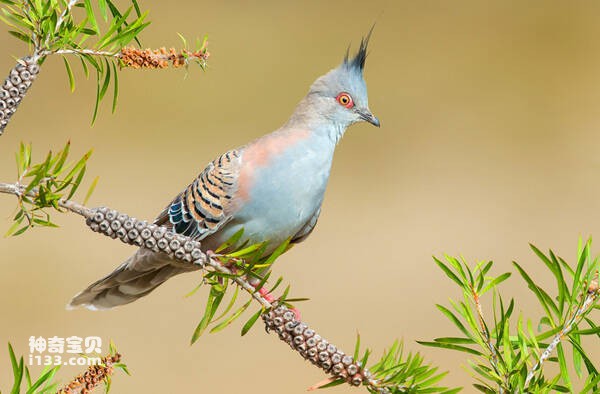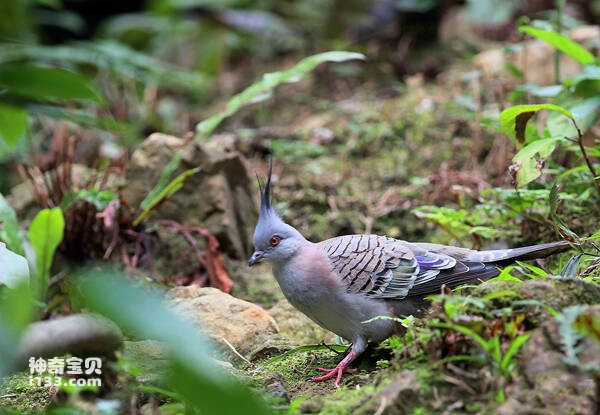Ocyphaps lophotes
IUCN
LCBasic Information
Scientific classification
- name:Ocyphaps lophotes
- Scientific Name:Ocyphaps lophotes,Crested Pigeon
- Outline:Landfowl
- Family:
Vital signs
- length:32.5-35.5CM
- Weight:120-230g
- lifetime:About 30 years
Feature
There is a cluster of upright black crowns on the top of the head, which stand upright when running
Distribution and Habitat
It is found in Australia. Due to human activities, the establishment of pastures in Australia, etc., the habitat of this species has expanded (initially it only lived in western Australia).
They usually live in places that are dry but not far from water. It flies to the water shortly after sunrise and returns to drink at dusk. Artificial lakes and cattle channels open up new breeding areas for the Guanjiu.
Appearance
The crown dove is 32.5-35.5 cm long and weighs 120-230 grams. The body shape is beautiful, the feathers are generally brown gray, the chest and neck sides of the pink, on the top of its head has a cluster of upright black crest, elegant and simple, similar to the bun dove. This cluster stands upright while the crown dove runs. There is a bright, orange ring around the eyes. The wings are bronze with black stripes. The feathers have bright metallic purple and green patches and white stripes, with a few feathers having vivid browns, purples, blues and greens. The brown black tail has a slight glossy green tinge and a white trailing edge. The underbody is silver gray, and the wings are white.
The beak is black, the base gray, the iris orange-yellow to orange-red, and the legs and feet pink. Beak short, teeming waxy; Well-developed wings, good at flying; The tail is short and round; The legs are short, unwebbed and the back toes are at the same level as the first three toes.
The youn
Details
The Crested Pigeon (Ocyphaps lophotes) has two subspecies.

Pigeon milk is secreted under the action of prolactin (also known as prolactin) secreted by the posterior pituitary gland during brooding period. Pigeon milk is composed of fat particles, emulsified chylous fluid and lymph fluid exfoliated from the swollen flat epithelium in the lymphatic area of the bilateral side sac of female and male pigeons, that is, the crop bed lymph area. After colostrum stage, chylous fluid rich in emulsified fat particles is gradually added. In general, on the 4th to 5th day of incubation, the male and female pigeons' crop beds began to sprouted, and the blood vessels of the crop beds were congested, thickened, and lymphatic vessels hyperplasia. On the 8th to 9th day, the crop epithelium thickened and entered the pre-brooding state. On the 13th day, the thickness and width of the pigeon had doubled, transparent yellowish milk could be secreted on the 14th to 16th day, the crop could secrete the throat milk on the 18th day, but on the 7th day after the squabs emerged from the shell, the secretion of the crop milk began to decrease, and on the 10th day, the secretion stopped, and the squabs continued to retching until about 2 weeks of age, the crop bed began to shrink, and the milk secretion gradually ceased. The chymous pulp is gradually mixed into the semi-finished chymous pulp which is backflowed from the glandular stomach and ground through the muscle stomach, and then it is changed into the granule feed which is directly fed with water. If the eggs do not come out on time, the hatchlings with good hatchability can continue to incubate until the 22nd to 24th day (these are related to the hatchability of the pigeons, the incubation season and the feedback of embryonic development information, the frequency of breaking the shell of the chicks, etc., such as in the cold winter and spring and the brooding period, the incubation period is often automatically extended, and it is often difficult to persist in the hot and hot days). At this time, the brood will automatically stop brooding with the shrinkage of the crop bed.

Crested doves can incubate their eggs all year round, but rarely produce during the winter, generally preferring to incubate their eggs during the warmer months and being more prevalent in April-July. The nest is usually placed in a shrub or tree 5 meters above the ground, and is usually made of branches. Two ellipsoidal, white, shiny eggs are laid at a time. The incubation period lasts 8-20 days. The nestlings weigh 9-10 grams at birth and are covered with thick brown downy hairs, and grow full plumage after 13-15 days, at which point they look like a miniature adult bird, with and having developed a crest. In captivity, chicks are away from the nest for 16 to 35 days.
Listed on the International Union for Conservation of Nature (IUCN) 2012 Red List of Threatened Species ver 3.1 - Not Threatened (LC).
Protect wild animals and eliminate wild meat.
Maintaining ecological balance is everyone's responsibility!








